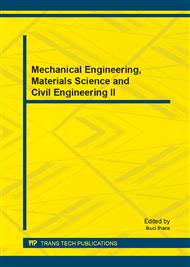[1]
Ahadzie, D. K., Proverbs, D. G., & Olomolaiye, P. O. (2008). Critical success criteria for mass house building projects in developing countries. International Journal of Project Management, 26(6), 675-687.
DOI: 10.1016/j.ijproman.2007.09.006
Google Scholar
[2]
Elinwa, A. U., & Buba, S. A. (1993). Construction cost factors in Nigeria. Journal of Construction Engineering and Management, 119(4), 698-713.
DOI: 10.1061/(asce)0733-9364(1993)119:4(698)
Google Scholar
[3]
Akintoye, A. (2000). Analysis of factors influencing project cost estimating practice. Construction Management and Economics, 18(1), 77-89.
DOI: 10.1080/014461900370979
Google Scholar
[4]
Chan, S. L., & Park, M. (2005). Project cost estimation using principal component regression. Construction Management and Economics, 23(3), 295-304.
DOI: 10.1080/01446190500039812
Google Scholar
[5]
Stoy, C., & Schalcher, H. -R. (2007). Residential building projects: building cost indicators and drivers. Journal of Construction Engineering and Management, 133(2), 139-145.
DOI: 10.1061/(asce)0733-9364(2007)133:2(139)
Google Scholar
[6]
Stoy, C., Pollalis, S., & Schalcher, H. -R. (2008). Drivers for cost estimating in early design: Case study of residential construction. Journal of Construction Engineering and Management, 134(1), 32-39.
DOI: 10.1061/(asce)0733-9364(2008)134:1(32)
Google Scholar
[7]
Elhag, T. M. S., Boussabaine, A. H., & Ballal, T. M. A. (2005). Critical determinants of construction tendering costs: Quantity surveyors' standpoint. International Journal of Project Management, 23(7), 538-545.
DOI: 10.1016/j.ijproman.2005.04.002
Google Scholar
[8]
Rasli, A. (2006). Data Analysis and Interpretation-A Handbook for Postgraduate Social Scientists (+ CD). Penerbit UTM.
Google Scholar
[9]
Lovie, P. (2005). Coefficient of variation. Encyclopedia of statistics in behavioral science.
Google Scholar
[10]
Kendall, M. G., & Smith, B. B. (1939). The problem of m rankings. The Annals of Mathematical Statistics, 10(3), 275-287.
Google Scholar
[11]
Aibinu, A. A., & Pasco, T. (2008). The accuracy of pre-tender building cost estimates in Australia. Construction Management and Economics, 26(12), 1257-1269.
DOI: 10.1080/01446190802527514
Google Scholar
[12]
Drew, D., & Skitmore, M. (1997). The effect of contract type and size on competitiveness in bidding. Construction Management and Economics, 15(5), 469-489.
DOI: 10.1080/014461997372836
Google Scholar
[13]
Kumaraswamy, M. M., & Chan, D. W. M. (1995). Determinants of construction duration. Construction Management and Economics, 13(3), 209-217.
DOI: 10.1080/01446199500000025
Google Scholar
[14]
Love, P. E. D., Tse, R. Y. C., & Edwards, D. J. (2005). Time-cost relationships in Australian building construction projects. Journal of Construction Engineering and Management, 131(2), 187-194.
DOI: 10.1061/(asce)0733-9364(2005)131:2(187)
Google Scholar
[15]
Ogunsemi, D. R., & Jagboro, G. O. (2006). Time-cost model for building projects in Nigeria. Construction Management and Economics, 24(3), 253-258.
DOI: 10.1080/01446190500521041
Google Scholar
[16]
Dursun, O., & Stoy, C. (2011). Time-cost relationship of building projects: statistical adequacy of categorization with respect to project location. Construction Management and Economics, 29(1), 97-106.
DOI: 10.1080/01446193.2010.528437
Google Scholar
[17]
Egemen, M., & Mohamed, A. N. (2007). A framework for contractors to reach strategically correct bid/no bid and mark-up size decisions. Building and Environment, 42(3), 1373-1385.
DOI: 10.1016/j.buildenv.2005.11.016
Google Scholar


